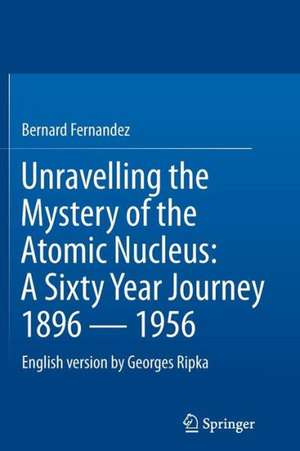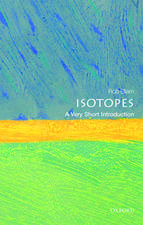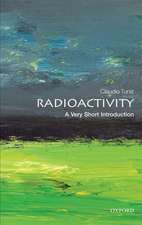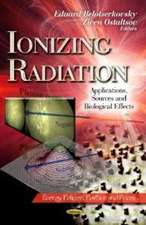Unravelling the Mystery of the Atomic Nucleus: A Sixty Year Journey 1896 — 1956
Autor Bernard Fernandez, Georges Ripkaen Limba Engleză Paperback – 15 oct 2014
Unlike previous books regarding on history of nuclear physics, this book methodically describes how advances in technology enabled physicists to probe the physical properties of nuclei as well as how the physical laws which govern these microscopic systems were progressively discovered. The reader will gain a clear understanding of how theory is inextricably intertwined with the progress of technology.
Unravelling the Mystery of the Atomic Nucleus will be of interest to physicists and to historians of physics, as well as those interested development of science.
| Toate formatele și edițiile | Preț | Express |
|---|---|---|
| Paperback (1) | 402.76 lei 6-8 săpt. | |
| Springer – 15 oct 2014 | 402.76 lei 6-8 săpt. | |
| Hardback (1) | 410.28 lei 6-8 săpt. | |
| Springer – 28 sep 2012 | 410.28 lei 6-8 săpt. |
Preț: 402.76 lei
Nou
Puncte Express: 604
Preț estimativ în valută:
77.07€ • 80.31$ • 63.81£
77.07€ • 80.31$ • 63.81£
Carte tipărită la comandă
Livrare economică 03-17 aprilie
Preluare comenzi: 021 569.72.76
Specificații
ISBN-13: 9781489985620
ISBN-10: 148998562X
Pagini: 548
Ilustrații: XVIII, 530 p.
Dimensiuni: 155 x 235 x 29 mm
Greutate: 0.76 kg
Ediția:2013
Editura: Springer
Colecția Springer
Locul publicării:New York, NY, United States
ISBN-10: 148998562X
Pagini: 548
Ilustrații: XVIII, 530 p.
Dimensiuni: 155 x 235 x 29 mm
Greutate: 0.76 kg
Ediția:2013
Editura: Springer
Colecția Springer
Locul publicării:New York, NY, United States
Public țintă
ResearchCuprins
Radioactivity, the First Puzzles.- A Nucleus at the Heart of The Atom.- Quantum Mechanics, the Unavoidable Path.- A Timid Infancy.- 1930-1940 : A Dazzling Development.- The Upheavals of the Second World War.- The Time of Maturity.- Where the Narrative Ends.
Recenzii
From the reviews:
“This work details the birth of nuclear physics in 1896 and its progression to maturity by the 1950s. … Readers truly interested in the journey itself will be well pleased with the book … . Using extensive quotations from primary sources and emphasizing experimental techniques and instrumentation, Fernandez brings the journey alive to deliver an authentic experience. … It is an easy read, free of mathematics, and suitable for nonscientists. Summing Up: Highly recommended. Upper-division undergraduates through professionals; general readers.” (P. Oxley, Choice, Vol. 50 (10), June, 2013)
“This work details the birth of nuclear physics in 1896 and its progression to maturity by the 1950s. … Readers truly interested in the journey itself will be well pleased with the book … . Using extensive quotations from primary sources and emphasizing experimental techniques and instrumentation, Fernandez brings the journey alive to deliver an authentic experience. … It is an easy read, free of mathematics, and suitable for nonscientists. Summing Up: Highly recommended. Upper-division undergraduates through professionals; general readers.” (P. Oxley, Choice, Vol. 50 (10), June, 2013)
Notă biografică
Bernard Fernandez, a graduate from the Ecole Polytechnique in Paris, is a physicist from Saclay, France, a laboratory of the French Atomic Energy Commission. He performed experiments on nuclear structure using the Van de Graaff Tandem accelerator and later on the GANIL heavy ion accelerator located in Caen. From 1965 to 1967 he spent two years in the University of Washington in Seattle and in 1976-1977 a year at the Niels Bohr Institute in Copenhagen. In 2008 the French edition of this book was awarded the Médaille Marc-Auguste Pictet by the Physics and Natural History Society of Geneva.
Georges Ripka, a physicist from the same laboratory in Saclay, worked on nuclear theory, condensed matter and particle physics. In 1963 he spent a year in the University of Pittsburgh and a further two sabbatical years in the University of Princeton (1967) and the Massachusetts Institute of Technology (1978). Since 1999 he has also worked in the European Center for Theoretical Physics in Trento, Italy. He is the author of several books, including Quantum Theory of Finite Systems (co-author with Jean Paul Blaizot), MIT Press, 1986 and Vivre Savant sous le communisme, Editions Belin, 2002. In 1995 he was awarded the Alexander von Humboldt Stiftung prize.
Georges Ripka, a physicist from the same laboratory in Saclay, worked on nuclear theory, condensed matter and particle physics. In 1963 he spent a year in the University of Pittsburgh and a further two sabbatical years in the University of Princeton (1967) and the Massachusetts Institute of Technology (1978). Since 1999 he has also worked in the European Center for Theoretical Physics in Trento, Italy. He is the author of several books, including Quantum Theory of Finite Systems (co-author with Jean Paul Blaizot), MIT Press, 1986 and Vivre Savant sous le communisme, Editions Belin, 2002. In 1995 he was awarded the Alexander von Humboldt Stiftung prize.
Textul de pe ultima copertă
Unravelling the Mystery of the Atomic Nucleus tells the story of how, in the span of barely sixty years, we made a transition from the belief that matter was composed of indivisible atoms, to the discovery that in the heart of each atom lies a nucleus which is ten thousand times smaller than the atom, which nonetheless carries almost all its mass, and the transformations of which involve energies that could never be reached by chemical reactions. It was not a smooth transition. The nature of nuclei, their properties, the physical laws which govern their behaviour, and the possibility of controlling to some extent their transformations, were discovered in discontinuous steps, following paths which occasionally led to errors which in turn were corrected by further experimental discoveries. The story begins in 1896 when radioactivity was unexpectedly discovered and continues up to the nineteen-sixties. The authors describe the spectacular progress made by physics during that time, which not only revealed a new form of matter, namely nuclei, but also modified our way of thinking by developing quantum mechanics and the theory of relativity.
The book is written in a clear and non mathematical language which makes it both accessible and instructive to laymen, physicists and students, as well as to historians of science. It delves into subjects which are of utmost importance for the understanding of matter in our universe and for understanding how this knowledge was achieved.
The book is written in a clear and non mathematical language which makes it both accessible and instructive to laymen, physicists and students, as well as to historians of science. It delves into subjects which are of utmost importance for the understanding of matter in our universe and for understanding how this knowledge was achieved.
Caracteristici
A non-technical and non-mathematical account of how atomic nuclei were discovered and the physical laws which govern them A comprehensive account of the historical development of nuclear physics, both from the experimental and the theoretical point of view Physicists who contributed to these developments are presented in their historical context with biographical details











